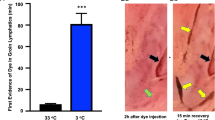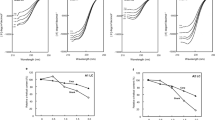Abstract
A STUDY of the permeability of isolated frog muscle fibres to glycerol, urea and its derivatives, amides and glycols led to the observation that fibres become filled with vacuoles, clearly visible under the light microscope, when they are returned to Ringer solution after being kept for 30–300 min in Ringer to which 220 mM of one of these non-electrolytes has been added1,2. The changes in fibre structure begin 1–2 min after the fibre has been returned to normal Ringer solution and attain their maximum in 15–20 min. If the fibre is left in Ringer solution, these alterations either persist for many hours or disappear gradually so that 2–4 h later the fibre structure is completely or partially restored to normal. As a rule, however, the vacuolation disappears within 3–10 min if the fibre is returned to the same non-electrolyte solution the washing out of which led to vacuolation in the first place, or if it is transferred to Ringer solution with an equal concentration of another, more slowly penetrating, non-electrolyte.
This is a preview of subscription content, access via your institution
Access options
Subscribe to this journal
Receive 51 print issues and online access
$199.00 per year
only $3.90 per issue
Buy this article
- Purchase on Springer Link
- Instant access to full article PDF
Prices may be subject to local taxes which are calculated during checkout
Similar content being viewed by others
References
Krolenko, S. A., and Adamjan, S. Ja., Tsitologiya, 9, 185 (1967).
Krolenko, S. A., Adamjan, S. Ja., and Shwinka, N. E., Tsitologiya, 9, 1346 (1967).
Krolenko, S. A., Tsitologiya, 10, 804 (1968).
Huxley, H. E., Nature, 202, 1067 (1964).
Page, S., J. Physiol., 175, 10P (1964).
Howell, J. N., and Jenden, D. J., Fed. Proc., 26, 553 (1967).
Eisenberg, R. S., and Gage, P. W., Science, 158, 1700 (1967).
Gage, P. W., and Eisenberg, R. S., Science, 158, 1702 (1967).
Huxley, H. E., Page, S., and Wilkie, D. R., J. Physiol., 169, 325 (1963).
Freygang, W. H., Goldstein, D. A., Hellam, D. C., and Peachey, L. D., J. Gen. Physiol., 48, 235 (1964).
Girardier, L., Dreifuss, J. J., Haenni, B., and Petrovici, A., Path. Microbiol. (Basel), 27, 16 (1964).
Freygang, W. H., Rapoport, S. I., and Peachey, L. D., J. Gen. Physiol, 50, 2437 (1967).
Girardier, L., Reuben, J. P., Brandt, P. W., and Grundfest, H., J. Gen. Physiol., 47, 189 (1963).
Foulks, J. G., Pacey, J. A., and Perry, F. A., J. Physiol., 180, 96 (1965).
Cochrane, D. G., and Elder, H., J. Physiol., 191, 30P (1967).
Author information
Authors and Affiliations
Rights and permissions
About this article
Cite this article
KROLENKO, S. Changes in the T-System of Muscle Fibres under the Influence of Influx and Efflux of Glycerol. Nature 221, 966–968 (1969). https://doi.org/10.1038/221966a0
Received:
Revised:
Issue Date:
DOI: https://doi.org/10.1038/221966a0
This article is cited by
-
The afterdepolarization in Rana temporaria muscle fibres following osmotic shock
Journal of Muscle Research and Cell Motility (1995)
-
Reversible vacuolation of the transverse tubules of frog skeletal muscle: a confocal fluorescence microscopy study
Journal of Muscle Research and Cell Motility (1995)
-
The subcellular location of potassium flux pathways in frog skeletal muscle
Pfl�gers Archiv European Journal of Physiology (1981)
-
Effect of glycerol treatment on sodium and potassium in isolated muscle fibres of the frog
Experientia (1980)
-
Passive transfer of low-molecular nonelectrolytes across deformable semipermeable membranes—I: Equations of convective-diffusion transfer of nonelectrolytes across deformable membranes of large curvature
Bulletin of Mathematical Biology (1974)
Comments
By submitting a comment you agree to abide by our Terms and Community Guidelines. If you find something abusive or that does not comply with our terms or guidelines please flag it as inappropriate.



